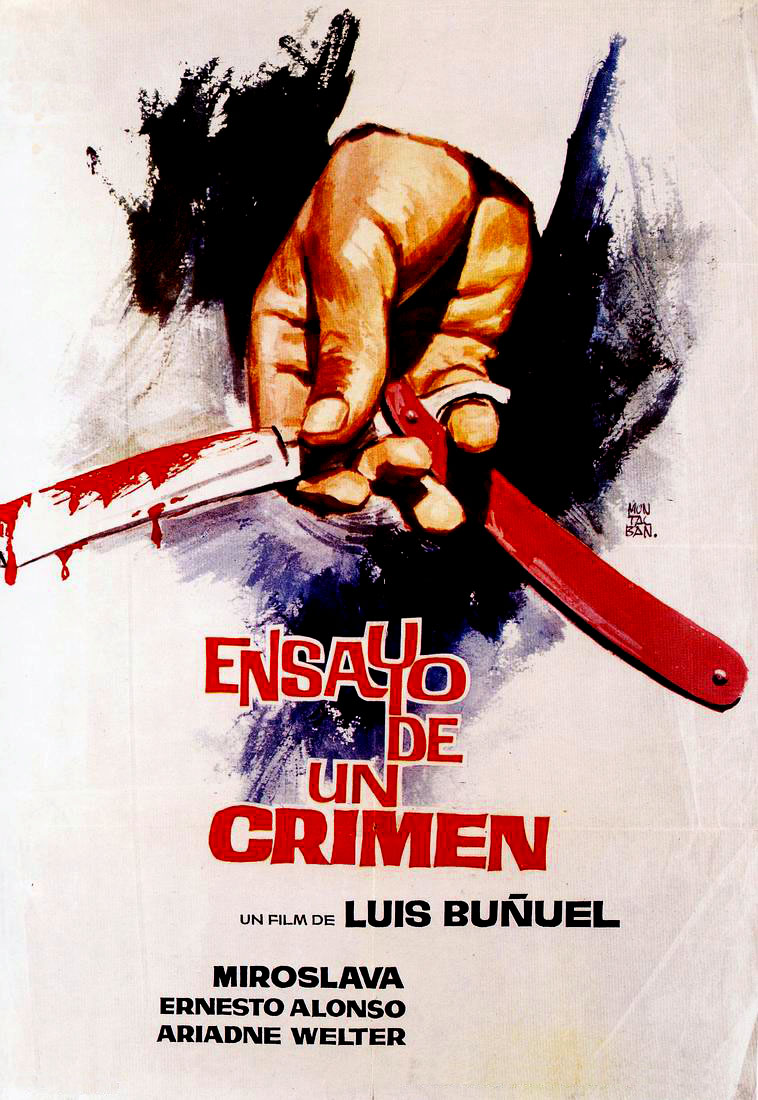- Ensayo de un crimen
Infobox_Film
name = Ensayo de un Crimen

caption = Ensayo de un Crimen poster
writer =Luis Buñuel Eduardo Ugarte Rodolfo Usigli
starring =Miroslava Stern Ernesto Alonso Rita Macedo Ariadna Welter
director =Luis Buñuel
producer =Alfonso Patiño Gómez
movie_music =
distributor =Alianza Cinematográfica
released =19 May 1955 (Mexico )
runtime = 89 min.
language = Spanish
music =Jorge Pérez Herrera
awards = | imdb_id = 0048037
budget ="Ensayo de un Crimen" is a
1955 Mexican film by Spanish-born directorLuis Buñuel , known in English as "The Criminal Life of Archibald de la Cruz". It focuses on a would-beserial killer whose plans, although elaborate, never result in an actual murder.Plot
Archibaldo de la Cruz (Alonso) is a wealthy Mexican man. As a privileged child during the
Mexican Revolution , he witnessed the death of hisgoverness , who died as she told him a fable about amusic box that his mother had just given him. Because of the contents of the story and the coincidental timing of the governess's death, a young Archibaldo concludes that he had killed the woman using the music box. It is from there that his desire to kill begins.As an adult, Archibaldo relates this story to a
nun , and threatens to kill her with astraight razor . The terrified woman runs from Archibaldo, eventually running into an empty elevator shaft to her death. Archibaldo is called in by a judge investigating the incident. He confesses that he is responsible for her death, and for many others.Patricia Terrazas (Macedo), is rather loud and constantly at conflict with her husband. After witnessing a fight between her and her husband, Archibaldo follows her and offers to drive her home, which she accepts. On arriving, he fantasizes of killing her with his
straight razor , but is interrupted when her husband returns home. The next morning apolice officer arrives at Archibaldo's home, with news that Patricia had committed suicide.Next, Archibaldo turns his attention to Carlota Cervantes (Welter), a woman who outwardly appears very religious, and is purported to be a
virgin . However, she is having an affair with a married man. Archibaldo approaches her saying that he is very conflicted between good and evil. He thinks that Carlota can fix his problems, and proposes to marry her.In the meantime, Archibaldo pursues another woman, Lavinia (Stern), whom he met in a bar. Lavinia works as a model for
mannequin s, and also shows American tourists around town. Archibaldo invites Lavinia to his home under false pretenses. He tells her that when they met, she reminded him ofJoan of Arc being consumed by flames. He plots tostrangle her and burn her in akiln , but unexpectedly, the doorbell rings. It is Lavinia's tourist friends, the "gringüitos". Lavinia has a disappointed Archibaldo take them on a tour of his home. When they leave, Lavinia says that she must go as well, and that she cannot see Archibaldo again because she is getting married.Just as this is happening, Carlota comes in with her mother to accept Archibaldo's proposal. But Archibaldo soon learns of her adulterous relationship, and is displeased. He fantasizes about making her kneel and
pray on her wedding night, and shooting her while she is praying. The wedding goes through, however, her jilted ex-lover ends up shooting her instead.After having heard all of this, the judge says that Archibaldo has committed no crimes, and that merely thinking of killing people is not a crime. Archibaldo, despite his intense feelings of guilt, is deemed innocent. As if to be processing this unexpected reaction, Archibaldo takes a walk in the park. He then throws his music box into a lake, and moves on. He runs into Lavinia, whose marriage did not work out. The two walk together and the film ends.
Academic Criticism
The film has been analyzed and studied by international academicians such as Victor Fuentes and Gerardo T. Cummings. Fuentes, a retired professor from
University of California, Santa Barbara , has included chapters dedicated to the detailed analytical study of "Ensayo de un crimen". His last book, "La mirada de Buñuel" (Spain: Tabla Rasa Libros y Ediciones, 2006) Furthermore, he has also found correlations between "Ensayo de un crimen" and "Él". Gerardo T. Cummings, on the other hand, published an article--published in 2004 by the Puerto Rican journal "Revista Horizontes"--on the intertextual connections between the cinematic version and the original literary source, the novel byRodolfo Usigli . The article was part of a larger dissertation chapter on the echoes of the novel in the film. Other critics who have dissected the film version of "Ensayo de un crimen" have been Marsha Kinder and Ilan Stavans.External links
*imdb title | id=0048037 | title=Ensayo de un Crimen
*Article in Spanish that compares the film version to the literary source
Wikimedia Foundation. 2010.
